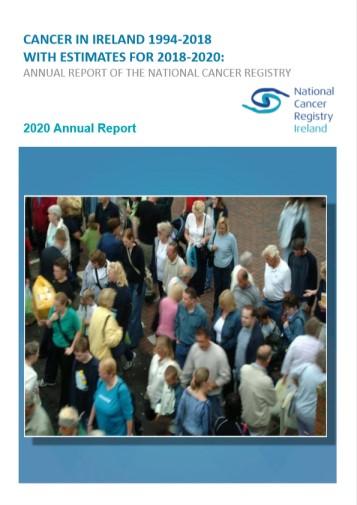Cancer in Ireland 1994-2018 with Estimates for 2018-2020: Annual Report of the National Cancer Registry

Updated statistics on cancer incidence, mortality and survival, published today (1st December 2020) by the National Cancer Registry (NCRI), document ongoing increases in numbers of cases diagnosed (largely driven by population growth and ageing) but also increases in survival and in numbers of cancer survivors.
- It is estimated that, on average, about 36,907 invasive cancers were diagnosed annually during 2018-2020, or 24,793 cancers excluding the common but rarely fatal non-melanoma skin cancer. (In total, an estimated 44,753 cancers and non-invasive tumours registrable by NCRI were diagnosed annually in the same period). Across most forms of the disease, men were more likely to have a cancer diagnosis than women, and age-standardised rates were about 20% higher in men for all cancers combined (excluding non-melanoma skin cancer).
- These figures were estimated using rates during 2016-2018, taking account of population growth and ageing by 2020, and are subject to possible adjustment once fuller information is available on 2019 and 2020 cases.
- Trends and projections for cancer incidence in Ireland published by NCRI last year show that, when we account for population growth and ageing, rates have generally stabilised or even declined in recent years. However, population growth and ageing will result in continuing increase in case numbers (potentially a doubling by 2045).
- Cancer is the most common cause of death in Ireland, accounting for almost 31% of deaths in 2017, and an annual average of 9,063 deaths from invasive cancer occurred during 2015-2017. Lung cancer was the leading cause of cancer death in both sexes, accounting for 20% of cancer deaths in women and 22% in men. The risk of dying of cancer was about 33% higher for men than for women.
- Survival for Irish cancer patients continues to improve. Five-year net survival for patients based on follow-up during 2012-2016 averaged 63% for men and 61% for women (excluding non-melanoma skin cancers), up from 39% in men and 46% in women diagnosed during 1994-1999. Significant survival improvements are evident for most types of cancer.
- Comparisons of five-year net survival during 2010-2014 between Ireland and other countries in the EU, as part of the global CONCORD-3 project, show that Ireland ranked in the top half of countries surveyed for 14 out of 18 common cancers studied, and that Ireland’s rankings are generally improving. But there is still scope for improvement, particularly for some cancers such as colon, breast and ovarian cancer. For the period 2010-2014, Ireland’s survival ranking among EU countries was highest for cancers of the oesophagus (4th), pancreas (8th), lung (6th), melanoma skin (8th), prostate (6th), brain (adults 4th and children 7th), myeloid and lymphoid cancers in adults (5th and 6th respectively) and lymphoma in children (4th).
- Reflecting population growth and survival gains, the number of people living with and beyond cancer (cancer prevalence) continues to grow. There were an estimated 190,000 people living after a diagnosis of invasive cancer other than non-melanoma skin cancer at the end of 2018. This figure is equivalent to 3.9% of the Irish population, and is likely to exceed 200,000 by the end of 2020. Cancer prevalence was highest for breast cancer (23% of all cancer survivors), prostate cancer (21%), and colorectal cancer (12%).
Share this page